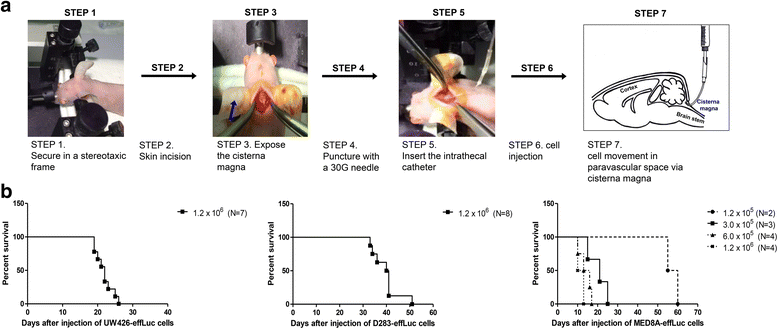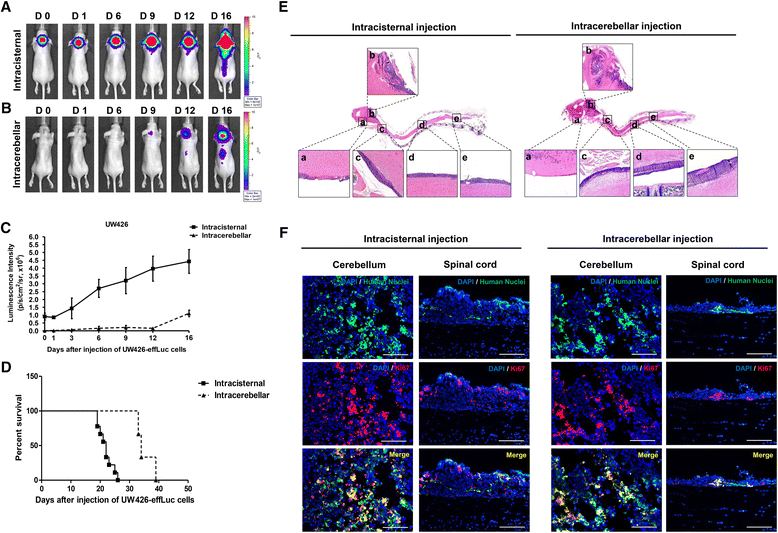In vivo bioluminescence imaging for leptomeningeal dissemination of medulloblastoma in mouse models
- PMID: 27609092
- PMCID: PMC5016924
- DOI: 10.1186/s12885-016-2742-y
In vivo bioluminescence imaging for leptomeningeal dissemination of medulloblastoma in mouse models
Abstract
Background: The primary cause of treatment failure in medulloblastomas (MB) is the development of leptomeningeal dissemination (seeding). For translational research on MB seeding, one of the major challenges is the development of reliable experimental models that simulate the seeding and growth characteristics of MBs. To overcome this obstacle, we improved an experimental mouse model by intracisternal inoculation of human MB cells and monitoring with in vivo live images.
Methods: Human MB cells (UW426, D283 and MED8A) were transfected with a firefly luciferase gene and a Thy1.1 (CD90.1) marker linked with IRES under the control of the CMV promoter in a retroviral DNA backbone (effLuc). The MB-effLuc cells were injected into the cisterna magna using an intrathecal catheter, and bioluminescence images were captured. We performed histopathological analysis to confirm the extent of tumor seeding.
Results: The luciferase activity of MB-effLuc cells displayed a gradually increasing pattern, which correlated with a quantitative luminometric assay. Live imaging showed that the MB-effLuc cells were diffusely distributed in the cervical spinal cord and the lumbosacral area. All mice injected with UW426-effLuc, D283-effLuc and MED8A-effLuc died within 51 days. The median survival was 22, 41 and 12 days after injection of 1.2 × 10(6) UW426-effLuc, D283-effLuc and MED8A-effLuc cells, respectively. The histopathological studies revealed that the MB-effLuc cells spread extensively and diffusely along the leptomeninges of the brain and spinal cord, forming tumor cell-coated layers. The tumor cells in the subarachnoid space expressed a human nuclei marker and Ki-67. Compared with the intracerebellar injection method in which the subfrontal area and distal spinal cord were spared by tumor cell seeding in some mice, the intracisternal injection model more closely resembled the widespread leptomeningeal seeding observed in MB patients.
Conclusion: The results and described method are valuable resources for further translational research to overcome MB seeding.
Keywords: In vivo bioluminescence imaging; Intracisternal injection; Leptomeningeal seeding; Medulloblastoma.
Figures




Similar articles
-
Reovirus prolongs survival and reduces the frequency of spinal and leptomeningeal metastases from medulloblastoma.Cancer Res. 2003 Jun 15;63(12):3162-72. Cancer Res. 2003. PMID: 12810644
-
miR-192 suppresses leptomeningeal dissemination of medulloblastoma by modulating cell proliferation and anchoring through the regulation of DHFR, integrins, and CD47.Oncotarget. 2015 Dec 22;6(41):43712-30. doi: 10.18632/oncotarget.6227. Oncotarget. 2015. PMID: 26506238 Free PMC article.
-
Distinct patterns of human medulloblastoma dissemination in the developing chick embryo nervous system.Clin Exp Metastasis. 2012 Apr;29(4):371-80. doi: 10.1007/s10585-012-9456-6. Epub 2012 Feb 10. Clin Exp Metastasis. 2012. PMID: 22322278
-
Primary leptomeningeal medulloblastoma: a case-based review.Childs Nerv Syst. 2022 Mar;38(3):527-536. doi: 10.1007/s00381-021-05435-x. Epub 2022 Jan 21. Childs Nerv Syst. 2022. PMID: 35059784 Review.
-
Medulloblastoma stem cells: Promising targets in medulloblastoma therapy.Cancer Sci. 2016 May;107(5):583-9. doi: 10.1111/cas.12925. Epub 2016 Apr 27. Cancer Sci. 2016. PMID: 27171351 Free PMC article. Review.
Cited by
-
The molecular biology of medulloblastoma metastasis.Brain Pathol. 2020 May;30(3):691-702. doi: 10.1111/bpa.12811. Epub 2020 Jan 15. Brain Pathol. 2020. PMID: 31883407 Free PMC article. Review.
-
Panobinostat, a histone deacetylase inhibitor, suppresses leptomeningeal seeding in a medulloblastoma animal model.Oncotarget. 2017 May 24;8(34):56747-56757. doi: 10.18632/oncotarget.18132. eCollection 2017 Aug 22. Oncotarget. 2017. PMID: 28915627 Free PMC article.
-
Proteomic profiling of cerebrospinal fluid reveals TKT as a potential biomarker for medulloblastoma.Sci Rep. 2024 Sep 10;14(1):21053. doi: 10.1038/s41598-024-71738-z. Sci Rep. 2024. PMID: 39251709 Free PMC article.
-
Combination Treatment of CI-994 With Etoposide Potentiates Anticancer Effects Through a Topoisomerase II-Dependent Mechanism in Atypical Teratoid/Rhabdoid Tumor (AT/RT).Front Oncol. 2021 Jul 21;11:648023. doi: 10.3389/fonc.2021.648023. eCollection 2021. Front Oncol. 2021. PMID: 34367950 Free PMC article.
-
Anti-EGFR VHH-armed death receptor ligand-engineered allogeneic stem cells have therapeutic efficacy in diverse brain metastatic breast cancers.Sci Adv. 2021 Mar 3;7(10):eabe8671. doi: 10.1126/sciadv.abe8671. Print 2021 Mar. Sci Adv. 2021. PMID: 33658202 Free PMC article.
References
Publication types
MeSH terms
LinkOut - more resources
Full Text Sources
Other Literature Sources
Miscellaneous

